This blog serves several purposes: Communicating with my students outside of the classroom, publishing my students' work, and it serves as a resource for both students and teachers.
Friday, December 12, 2008
東洋学園大学 Travel English 2008 Semester 2 - Last class!
Today is the last class. The next time we meet will be the final exam. The final exam is on the nineth of January. The final exam covers units 2,3,4,5,7,9,12,14,15,16, and 20. Please click here to practice the final exam: Passport Online tests. Merry Christmas!
東洋学園大学 Annual Christmas Party in the English Lounge
Wednesday, December 10, 2008
東洋学園大学 Interest-based English - Homestay English Final Exam Study Guide

The final exam is on the fourteenth of January. Click this link for information about the final exam: Homestay English Final Exam Study Guide. Click here to practice the vocabulary: TGU IE12 Homestay Final Exam 2008 List.
Friday, December 05, 2008
東洋学園大学 Interest-based English - Travel: Peace Boat and Global English Special Presentation
- There are about 2,000,000,000 English speakers in the world
- There are only about 400,000,000 native speakers of English in the world
- Only about 10% of all the English spoken in the world is between native speakers
- There is no "correct" English
- I went play in the park. (Hawaiian English)
- I am understanding it. (Indian English)
- Him will do it. (Jamaican English)
- Yous are amazing! (American English)
- This book you want or not? (Singaporean English)
- There is no correct English
- We should be proud of our accent
- Global English belongs to everyone

Thursday, December 04, 2008
Wednesday, December 03, 2008
Toyo Gakuen University Interest-based English 12 Music: Project 2 Lesson 2

Here are some links to help you:
Nippop.com
Wikipedia in English
Wikipedia in Japanese
Your powerpoint must be finished by the fourteenth of January.
Toyo Gakuen University Homestay English: Christmas in Tarragona
Today we are going to learn about Christmas in Tarragona, a city in Northern Spain. We are going to watch slideshows by students in one of our International Sister Classes. They are students at a school called IES Collblanc.
Please do the following:
- Open the lecture folder
- Save the file called "Tarragona" to your personal folder (自分のふぉフォルダー)
- Click the link: TARRAGONA & CHRISTMAS
- Log in to Student Showcase
- Watch the slideshows.
- Do the tasks on your tasksheet.
- Write a comment about the slideshows. Include:
- Your first name (名前)
- Thank you
- Your impression of Tarragona (~の[に対する]印象{いんしょう}を述べる)
- Your impression of Christmas in Tarragona
Saturday, November 29, 2008
ETJ Tokyo Expo at Toyo Gakuen University Hongo Campus
My powerpoint presentation is below.
This is a slideshow of a list roll I made for my presentation.
Thursday, November 27, 2008
Toyo Gakuen University Interest-based English - Travel: Shopping
In todays lesson we will learn about shopping.
Let's practice what we have learned from the textbook. Click this link: Passport Online.
Click this link to learn about famous shopping areas in London: London's favourite shopping streets.
Click this link to learn and practice some more shopping vocabulary. Shopping vocabulary, useful phrases, dialogues, games and tests.
Click these links to listen to conversations in London shops: Listen 1: Buying a pair of shoes. Listen 2: Buying a pair of jeans.. Finally, there are many more great sites listed on the website for Academie Nancy-Metz. Click this link: http://www.ac-nancy-metz.fr/enseign/anglais/Henry/mag.htm.
More Haiku by Toyo Gakuen University Extension Centre students
I found
A ginko nut near my house
in the park
by Kuniko
What is in my fridge?
Shrimp, salmon, and oysters are
I cannot eat more
by Miki
Toyo Gakuen University Freshman English 2 - Reading Midterm Exam Study Guide
- Timed reading: scan a reading for 1 minute in order to find specific information. This is a multiple choice type question.
- Reading for the main idea. This is a multiple choice type of question. You will have to choose from 4 choices.
- Reading for details. This is a multiple choice type of question. You will have to choose from 4 choices.
- Making inferences. This is a multiple choice type of question. You will have to choose from 4 choices.
- Matching activities: A. Match the vocabulary from the textbook with the Japanese translation. B. collocations.
- Personal response. This is a short paragraph type of answer. You will have to write 2 or 3 sentences in order to answer the question. Your answer should be at least 50 words.
Use the following resources in order to study for the exam:
- American Headway Level 2 Unit 6 Crossword
- Unit 8 Vocabulary Flashcards on Quizlet
- Unit 8 Vocabulary Flashcards on StudyStack
- Simple English News articles about Brad Pitt and Angelina Jolie, Madonna and Guy Ritchie, David and Victoria Beckham.
- Wikipedia articles about Milton Petrie, and Hetty Green, and Schenzen City.
Also, review these posts from Mr. Stout's Blog: Unit 7 - Celebrity Interview , Unit 8 - Dilemmas and look at these posts from Sarah's Blog: Unit 6, Unit 7, Unit 8.
Good luck!
Wednesday, November 26, 2008
Toyo Gakuen University Interest-based English 12 Music. Project 2. Lesson 1.
First, let's watch some of the presentations made by students last semester. Watch the presentations and answer the questions on the document called IE12 Powerpoint Questions. The document is in the lecture folder.
Now it's your turn. Here's your assignment:
Make a powerpoint presentation about a musical artist that you like.
Here's your project checklist:
- at least 5 slides in total
- a title slide
- a background slide including:
- When the band was formed
- Where the band was formed
- The members of the band
- The genre
- The most popular song
- Awards, trivia, record label (choose one)
For solo artists:
Where the artist was born- When the artist was born
- The artist's instrument
- The genre
- The most popular song
- Awards, trivia, record label (choose one)
- Two or more slides for profiles, discography, concerts (choose one)
Have fun!
Toyo Gakuen University Homestay English: Unit 9 - At a restaurant
Tuesday, November 25, 2008
Shibaura Institute of Technology Paragraph Writing 2 students write about their favourite architectural structures
 Seto bridge is a famous bridge in Kagawa and Okayama. It connects Kagawa and Okayama. It is a very large and long bridge, 9,368 meters long. It consists of three structures: two different styles of suspension bridge and a truss bridge. It has a four-lane expressway and a two-lane railroad. The Shikoku district has not Shinkansen, but it has plan for building a Shinkansen road. So Seto bridge was designed that it can add more two railroads. Its color is light gray. This color suits this place. You can see a beautiful view of the Seto Inland Sea when you drive or get into a train.
Seto bridge is a famous bridge in Kagawa and Okayama. It connects Kagawa and Okayama. It is a very large and long bridge, 9,368 meters long. It consists of three structures: two different styles of suspension bridge and a truss bridge. It has a four-lane expressway and a two-lane railroad. The Shikoku district has not Shinkansen, but it has plan for building a Shinkansen road. So Seto bridge was designed that it can add more two railroads. Its color is light gray. This color suits this place. You can see a beautiful view of the Seto Inland Sea when you drive or get into a train.Ayana S.
 Yokohama Landmark tower is a famous building. It is the tallest building made of concrete in Japan. It is 295.8 meters high. This building has 70 floors. It is made of concrete, glass and steel. The lower floors contain shops, restaurants, clinics, and offices. A hotel occupies forty-nineth to seventieth floors. This building has very many facilities. Yokohama Landmark tower is my favorite building.
Yokohama Landmark tower is a famous building. It is the tallest building made of concrete in Japan. It is 295.8 meters high. This building has 70 floors. It is made of concrete, glass and steel. The lower floors contain shops, restaurants, clinics, and offices. A hotel occupies forty-nineth to seventieth floors. This building has very many facilities. Yokohama Landmark tower is my favorite building.Satomi Y.
 This is a famous building in Kyoto. It is a tall building, 131meters high. It consists of two structures: a tall tower and a rectangular structure. The tower is on the rectangular structure. The rectangular structure is hotel and shopping area. You can get a great view of the city from a viewing platform at the top of the tower. The building is made of concrete, glass and iron. The building was made in 1964. This building is called Kyoto Tower.
This is a famous building in Kyoto. It is a tall building, 131meters high. It consists of two structures: a tall tower and a rectangular structure. The tower is on the rectangular structure. The rectangular structure is hotel and shopping area. You can get a great view of the city from a viewing platform at the top of the tower. The building is made of concrete, glass and iron. The building was made in 1964. This building is called Kyoto Tower.Kohei K
 This is a famous tower in Tokyo. It is a very large and tall building, 333 meters high. It is the tallest tower in Tokyo. It was built in 1958. The color of the building is red and white. It has a rectangular base and an antenna. The antenna is cylindrical and thin. The tower has a big observatory 150m from the ground and a small observatory 250m from the ground. You can get a great view of the city from the big observatory and the small observatory. The tower is made of concrete and glass. It is used mainly for a transmitter tower. It is a symbol of Tokyo. It is Tokyo Tower.
This is a famous tower in Tokyo. It is a very large and tall building, 333 meters high. It is the tallest tower in Tokyo. It was built in 1958. The color of the building is red and white. It has a rectangular base and an antenna. The antenna is cylindrical and thin. The tower has a big observatory 150m from the ground and a small observatory 250m from the ground. You can get a great view of the city from the big observatory and the small observatory. The tower is made of concrete and glass. It is used mainly for a transmitter tower. It is a symbol of Tokyo. It is Tokyo Tower.Akitsugu K.
 Horyu-ji is a famous building in Japan. It is an old temple in Nara and it was built by Prince Shotoku in 607 A.D. There is a five-storied pagoda in it, which is 24 meters high. Horyu-ji is the oldest wooden building in existence. At the gate of Horyu-ji, a pair of Kongorikishi statues stands. In 1993, Horyu-ji was registered on the UNESCO World Heritage List. So, all Japanese know this temple.
Horyu-ji is a famous building in Japan. It is an old temple in Nara and it was built by Prince Shotoku in 607 A.D. There is a five-storied pagoda in it, which is 24 meters high. Horyu-ji is the oldest wooden building in existence. At the gate of Horyu-ji, a pair of Kongorikishi statues stands. In 1993, Horyu-ji was registered on the UNESCO World Heritage List. So, all Japanese know this temple.Yukiya A.
 This is a famous building in Kyoto, which many people visit. It is small. It is three stories high. Although it was burned in 1950, it was rebuilt in 1955. You cannot enter it because it is old, thin and fragile. The building is made of wood and it is gilded. It was designed by Yoshimitsu Ashikaga. It is beautiful. It is a Kinkakuji.
This is a famous building in Kyoto, which many people visit. It is small. It is three stories high. Although it was burned in 1950, it was rebuilt in 1955. You cannot enter it because it is old, thin and fragile. The building is made of wood and it is gilded. It was designed by Yoshimitsu Ashikaga. It is beautiful. It is a Kinkakuji.Yuki K.
 The building is a university. It is located in Toyosu. Its material is reinforced concrete and its color is gray. Its shape is like The Arche de Triomphe. The size is about 25 meters high. The building has many windows, and has over 15 floors. You can get a great view of the city from the top floor. This building is S.I.T. Toyosu campus.
The building is a university. It is located in Toyosu. Its material is reinforced concrete and its color is gray. Its shape is like The Arche de Triomphe. The size is about 25 meters high. The building has many windows, and has over 15 floors. You can get a great view of the city from the top floor. This building is S.I.T. Toyosu campus.Daichi M.
 It is a famous building in Australia. It is a concert hall where orchestras play. It was designed by John Utsson, and made in 1973. It consists of the concert hall, the opera theater, the drama theater, the playhouse, and the studio theater. It is 180-meters in height. So, it is very high. It is a sharp face. It is made of granite and plywood. 1,056,500 tiles that were made in Sweden are
It is a famous building in Australia. It is a concert hall where orchestras play. It was designed by John Utsson, and made in 1973. It consists of the concert hall, the opera theater, the drama theater, the playhouse, and the studio theater. It is 180-meters in height. So, it is very high. It is a sharp face. It is made of granite and plywood. 1,056,500 tiles that were made in Sweden areon the roof. These tiles are very beautiful, and this building is a famous sightseeing spot. I like this place seen from the river. Especially, in the evening it is beautiful.
Shun T.
Friday, November 21, 2008
Toyo Gakuen University Interest-based English - Travel: Taking the bus
In today's lesson we will learn useful English that we can use on a bus.
First, let's practice some vocabulary. Click this link: Travel English Vocabulary: Using Public Transportation.
Here's a video about taking a bus in Tel Aviv, Isreal. Watch the video and do the quiz. There are 5 questions in the quiz.
Now, use the Currency conversion exchange widget on the right side of this page. How much is 10 Isreali sheqels in yen?
Click the link for more information on travelling in Isreal.
Thursday, November 20, 2008
Toyo Gakuen University student makes a movie.
Enjoy!
Wednesday, November 19, 2008
Homestays in Burundi, Portugal, The United States, and Tahiti
First let's practice some vocabulary. Click this link: http://www.wordchamp.com/lingua2/List.do?packItemID=123832930159397048
Now watch the videos. Answer the questions below for each video:
- Where do homestay guests stay?
- What do homestay guests eat?
- What do homestay guests do?
A Homestay in Portugal
A Homestay in San Francisco
A Homestay in Tahiti
Which homestay holiday would you like to do?
Leave a comment.
Toyo Gakuen University Interest-based English Semester 2 Music Genres Presentation
You are finished if you can check every box.
I have…
- uploaded a picture (1 point)
- given the picture a title.(1 point)
- included the URL of the picture (1 point)
- recorded my talk (2 points)
- recorded three questions about my talk (2 points)
- answered the questions asked by all members of the class (8 points)
- participated in a conversation of at least 6 turns with two people (5 points)
Watch the powerpoint presentations made by the students in last semester's class.
Enjoy!
Thursday, November 13, 2008
Haiku by Toyo Gakuen University Extension Centre Students
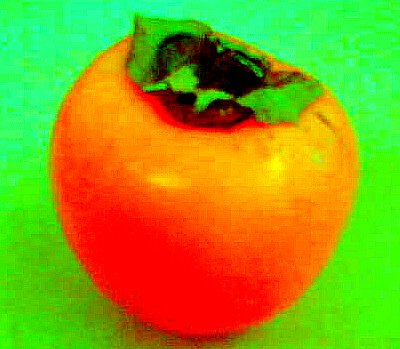
Persimmon
Originally uploaded by panduh
Wednesday, November 12, 2008
Toyo Gakuen University IE-12: Music. If Everyone Cared by Nickelback
I've posted about this song before.
Click here to see the earlier post: http://mrstoutsblog.blogspot.com/2007/06/y-ou-can-make-difference-video-by.html
Tuesday, November 11, 2008
November 11th: Remembrance Day, a day of Peace
Here is a beautiful poem. A Canadian soldier in World War 1 wrote the poem. I memorised the poem when I was a school boy. I recited the poem every Remembrance Day. I think it's a beautiful poem. I hope you do too.
In Flanders Fields
In Flanders fields the poppies blow
Between the crosses, row on row,
That mark our place; and in the sky
The larks, still bravely singing, fly
Scarce heard amid the guns below.
We are the Dead. Short days ago
We lived, felt dawn, saw sunset glow,
Loved and were loved, and now we lie,
In Flanders fields.
Take up our quarrel with the foe:
To you from failing hands we throw
The torch; be yours to hold it high.
If ye break faith with us who die
We shall not sleep, though poppies grow
In Flanders fields.
Sunday, November 09, 2008
Shibaura Institute of Technology English Conversation Intermediate 2 Mid-term Exam Study Guide
The midterm exam is next Saturday. You can prepare by practicing the tasks in the study guide that I sent to you by e-mail.
This video will help you do the second task.
Good luck!
Friday, November 07, 2008
Toyo Gakuen University Interest-based English - Travel: Lesson 7
Today we will learn useful English we can use in a restaurant.
The Smallest Restaurant in the World from mmmarzio on Vimeo.
Now let's practice.
- Click here: Passport Online.
- Move your cursor to 9 Are you ready to order
- Move your cursor to 9a What kind of food is this?
- Do the task
- Move your cursor to 9b Find the differences
- Do the task
- Click here: Passport Online tests
- Do the practice test
Thursday, November 06, 2008
Toyo Gakuen University Homestay English 2008 Midterm Exam Study Guide
Part 1: Vocabulary.
You must know the following words and phrases from your textbook:
- perplexing
- willing
- expression
- intimate
- inquire about
- transition
- curiosity
- affection
- dialect
- widen one’s horizons
Part2: Multiple choice questions about Units 1 - 6 in your textbook.
Part3: 2 short paragraph answer type questions. You will be asked to write one or two paragraphs for each question. Your answer should be between 50 words and 100 words.
Here are the questions:
*Describe a homestay trip that you would like to do in the future. Include the following points:
- Where you would like to do a homestay.
- Why you want to do a homestay.
- How you would prepare for the homestay.
- The type of homestay family you would like. For example: an older couple with no children, or a young couple with young children.
- What you would like to do during the homestay.
Study hard and good luck!
Wednesday, November 05, 2008
Toyo Gakuen University IE-12: Music. Yesterday by the Beatles
Now watch Yesterday with Japanese translation. Click this link: http://jp.yappr.com/welcome/Video.action?videoGuid=EB6EEBCA-C89A-4E64-81F0-CBF9BE3B2D21
Enjoy!!
PAC 7 at JALT 2008 - teachers and students learning together
Last weekend an amazing event happened at the National Olympics Memorial Youth Center in Yoyogi, Tokyo. The event was PAC 7 at JALT 2008. Students and teachers from Japan, Russia, and all over Asia took part in the event. One of the most impressive parts of the event was the Asian Youth Forum. Students from Asian countries took part in workshops and made presentations. They shared their culture and they shared their ideas.
Toyo Gakuen University teachers took part in the event too including Andy, Sarah, Claire, Cara, and me. Some Toyo Gakuen students volunteers as interns too. I hope more Toyo Gakuen University students will get involved next time.
Asian Youth Forum participants performing their native songs and dances.
Asian Youth Forum participants at the opening ceremony of PAC 7 at JALT 2008.
Yoko, a Toyo Gakuen student, serving as an intern at the conference.
Friday, October 31, 2008
Toyo Gakuen University Interest-based English - Travel: Lesson 6
Here's a video. Click this link: A Visit to the Doctor
Now let's practice. Click this link: Passport Online
Next, let's do a practice test. Click this link: Passport Online Test - Japanese
The midterm test is next Friday, 7 November 2008. You need to study units 2, 3, 4, 5 and 7.
Remember, if you study and prepare, the test will be easy.
Wednesday, October 29, 2008
Toyo Gakuen University IE-12 Music: Project 1 - Music Genres. Lesson 4
First lets listen to a song by a great Jazz musician, Louis Armstrong. Click this link: http://jp.yappr.com/welcome/Video.action?videoGuid=F4E844F5-347D-46B5-8242-E974FBCB911D
Now let's practice some vocabulary. Click this link: Music Vocabulary list 2
http://www.diigo.com/annotated/bd28df3af9b4b8dc93bf8e782b0ba1eb
For information on Rock click this link: http://www.diigo.com/annotated/007d114da2d93b2eda4889715aa75605
Enjoy!
Toyo Gakuen University Homestay English: Unit 6 - Meeting and talking with people
First, let's review some vocabulary. Please click this link: TGU IE2 Travel List 2.
Now let's join the International Sister Classes Forum. http://edublogs.org/wp-signup.php
Click here to see the Sister Classes Forum: http://esleflstudents.edublogs.org/sister-class-forum/
Next let's watch the video and answer the questions in the textbook.
Friday, October 24, 2008
Toyo Gakuen University Interest-based English - Travel: Lesson 5
View Larger Map
Unit 5: Go straight along Seventh Avenue
Today we are going to practice directions. We will practice asking for directions, and listening to directions.
First, let's practice some vocabulary.
Click this link: Travel Unit 5: Directions
Let's play a game. Click this link: http://www.studystack.com/menu-141943
Now let's practice using Passport Online
Finally let's do a practice test.
Wednesday, October 22, 2008
Toyo Gakuen University IE-12 Music: Project 1 - Music Genres. Lesson 3
Now let's start our project.
If you haven't decided which genre you want to research, click this link to find lists of music styles: http://en.wikipedia.org/wiki/List_of_music_styles
If you have decided which genre that you want to research, find the wikipedia page that you need. Here are some links for popular musical genres: Rock, J-Pop, Traditional Japanese music, Gospel, Classical, Blues, World Music, Hip Hop, Trance, Jazz, R&B.
Look at the picture below. The picture shows you where to click to see a wikipedia article in Japanese.
 Here's a link to help you find pictures: http://creativecommons.org/image/
Here's a link to help you find pictures: http://creativecommons.org/image/You can also find pictures on flickr. Click here: http://www.flickr.com/
Also, please read this article about copyright: http://ja.wikipedia.org/wiki/著作権
Finally, please read this article about Creative Commons licences: http://creativecommons.org/licenses/by/2.1/jp/
Ok, let's get started!
Toyo Gakuen University Homestay English Unit 5: Communicating with your homestay family
- Explaining your gift
- Explaining your hometown
- Personal Questions

Let's get started. Click here to open an Edubloggers' account: http://edublogs.org/wp-signup.php
Click here to see the Sister Classes Forum: http://esleflstudents.edublogs.org/sister-class-forum/
Sunday, October 19, 2008
A Model Language Learner: Ayumi Okada
 It's very useful to have a role model. A language learning role model is very useful. Last year, I posted a video interview with Miho on the Daily English Show. Miho is a model language learner. Last April, I wrote about my friend Sanae. Sanae is a model language learner. Today, I'm going to write about another model language learner, Ayumi Okada. Ayumi was a student at Kanto International High School. When Ayumi started at Kanto she couldn't speak English much at all. She was in the Regular course, not the English course. So, she didn't have many English classes, and she didn't have many native English speaking teachers. However, she joined the World School Society. As a member of the World School Society she attended the World School International Forums in Japan and in the United States. She made friends with young people from all over the world.
It's very useful to have a role model. A language learning role model is very useful. Last year, I posted a video interview with Miho on the Daily English Show. Miho is a model language learner. Last April, I wrote about my friend Sanae. Sanae is a model language learner. Today, I'm going to write about another model language learner, Ayumi Okada. Ayumi was a student at Kanto International High School. When Ayumi started at Kanto she couldn't speak English much at all. She was in the Regular course, not the English course. So, she didn't have many English classes, and she didn't have many native English speaking teachers. However, she joined the World School Society. As a member of the World School Society she attended the World School International Forums in Japan and in the United States. She made friends with young people from all over the world.
Ayumi is very very musical. Her dream was to study music in the U.K. So, she asked me to help her prepare for the IELTS exam. I did. She got a great score and she was able enter a college in the U.K. Now she is studying Popular Music and Record Production at Southampton Solent University. She presents a radio programme on SIN Radio. The radio programme is called D.J. Yummy's Japanese Takeaway. You can listen to D.J. Yummy's Japanese Takeaway on the internet. Her radio programme is on Thursdays from three o'clock to five o'clock Greenwich Mean Time, that's 11 pm. to 1 am. Japan Standard Time. Look at the picture below. Click this link: http://www.sinradio.co.uk/site/?function=schedule. Click "Listen".

D.J. Yummy's Japanese Takeaway is very good. I listen to D.J. Yummy's Japanese Takeaway. I hope you will too.
Wednesday, October 15, 2008
Toyo Gakuen University IE-12 Music: Project 1 Music Genres. Lesson 2
First, let's start by watching a Bob Marley video. Bob Marley was a reggae artist. Click this link to see the video: Bob Marley - No Woman No Cry.


Here's some information about Reggae:
Reggae was developed in Jamaica in the late sixties. Larry Marshall recorded the first reggae record in 1968. The record was called "Nanny Goat".
Reggae has these musical characteristics:
- 4/4 or Swing time
- Simple chords repeated
- a hypnotic effect (催眠効果)
Some famous reggae artists are: Bob Marley, Peter Tosh, Jimmy Cliff, and UB40
Some famous reggae songs are: "I Shot the Sheriff", The Harder They Come", and "Red Red Wine".
The main musical instruments used in reggae are guitars, bass, drums and sometimes horns.
Next, let's practice some vocabulary. Click this link: Music Vocabulary List 4.
Now, let's review last week's lesson.
Now lets begin our project. Click here: Voicethread.
Toyo Gakuen University Homestay English Unit 4: Fitting into American Homelife
 In today's lesson we will learn about helping around the house, helping yourself, and using the phone. Let's learn some vocabulary first. Click this link TGU IE2 Homestay List 3.
In today's lesson we will learn about helping around the house, helping yourself, and using the phone. Let's learn some vocabulary first. Click this link TGU IE2 Homestay List 3.What chores do you do at home? Please leave a comment.
Toyo Gakuen University Freshman English 4 - Semester 2 Test 1 Study Guide
The time has come. You will take your first test of semester 2 in your next class. Here's your task:
Roles: Caller, Receiver
Situation: There's a Hallowe'en Party in the English Lounge
Tasks:
A. Caller
- Call your new English friend Chrissie.
- When a different person answers your call, ask if you can leave a message for your friend.
- Leave a message:
a. Say your name
b. Spell your name
c. Say your telephone number
d. Say the day, time, and location of the party
B. Receiver
- Answer the call
- Take a message
- Check the information: caller's name, telephone number, details of the message
Unit 7 - Special Occasions
Taking and leaving a phone message
Pronunciation of "th"
Remember! If you prepare and practice you will get an "A".
Thursday, October 09, 2008
Toyo Gakuen University Interest-based English - Travel: Lesson 4
Unit 4: Do you have any vacancies.
Today we are going to learn about reserving a room in a hotel. First, let's review some vocabulary and learn some new words too. Click this link:Travel English E-J .
Now let's play some games and practice what we've learned from the textbook. Click here: Passport Online. Next, let's research some hotels. Click here: HotelTravel.com. Download the worksheet below. Do the task. Save the document in your folder.
Finally, let's do a practice test. Click here: Passport Tests.
Wednesday, October 08, 2008
Toyo Gakuen University IE-12 Music: Project 1 - Music Genres. Lesson 1
First, let's learn some vocabulary. Click the link: Music vocabulary list 2
Now let's watch two slideshows. I made the first slideshow. Toyo Gakuen University students made the next slide show. Make a coment.
My Slideshow about music genres
Toyo Gakuen Students slideshow about music genres
Here's a playlist of African music videos.
Here's a playlist of Jazz videos.
Click here to see a playlist of calyspo and soca videos: http://uk.youtube.com/view_play_list?p=7B5A9CDAFBFF6AEA
Now it's your turn to make a slide show about music genres.
Tuesday, October 07, 2008
Toyo Gakuen University Homestay English Unit 3: At Dinner
Japanese eat a morning meal (朝食), a midday meal (昼食) and an evening meal (夕食). Many people in other countries eat these meals too. So three meals a day is common everywhere, but sometimes the food is different.
In Canada, many people skip breakfast on weekdays. Some people only have a very light breakfast on weekdays. For example, some people just have coffee. Some people just drink a glass of juice. Some people eat fruit. Some people have a muffin and a coffee.

A muffin and a coffee is, perhaps, the most common weekday breakfast in Canada. Many people eat breakfast on the way to work. They buy a muffin and a coffee at fast-food restaurants including: Tim Hortons, Coffee Time, and Second Cup.

On weekends, sometimes Canadians eat big breakfasts. Click this link to see some popular breakfasts in Canada: http://www.flickr.com/photos/mc_sensei/sets/72157607825427625/
Britain is famous for it's breakfast. What kinds of food are in a full British breakfast? Click the link: http://www.flickr.com/photos/joits/164373609/

Click this link to learn about breakfast around the world:
http://en.wikipedia.org/wiki/Breakfast#Typical_breakfasts_by_world_regions
The midday meal in the United States and Canada is called lunch.
Click this link to read the wikipedia article about lunch in English: http://en.wikipedia.org/wiki/Lunch
Click this link to read the wikipedia article about lunch in Japanese: http://ja.wikipedia.org/wiki/%E6%98%BC%E9%A3%9F
The picture below is a picture of me having lunch at my aunt's house.
 Look at the table. Many Canadians serve each dish in a separate bowl or on a separate plate and put the dishes in the middle of the table. Everyone serves themselves. This is very convenient. You can take the dishes that you like.
Look at the table. Many Canadians serve each dish in a separate bowl or on a separate plate and put the dishes in the middle of the table. Everyone serves themselves. This is very convenient. You can take the dishes that you like.You can see the dishes I chose in the picture below. Click the picture. What kind of food is on my plate?
Now, let's learn about dinner.
Dinner is the main meal. In Canada, people eat dinner in the evening. In some countries, including Trinidad, people eat dinner in the afternoon. In England, dinner is called tea.
Finally, let's learn about table manners in America and some general etiquette in Canada and the United States.
Bon Appétit











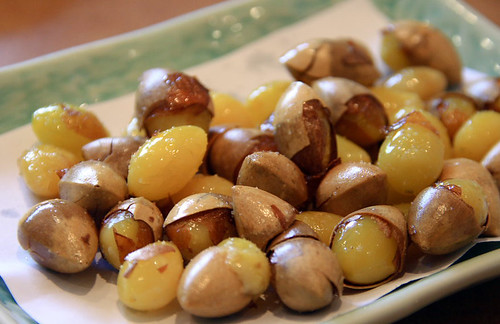

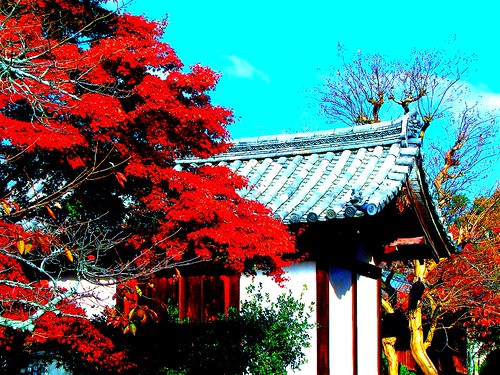


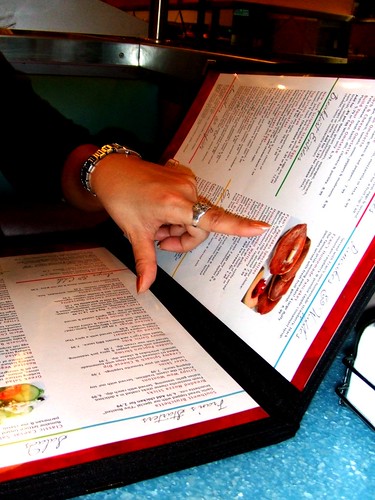
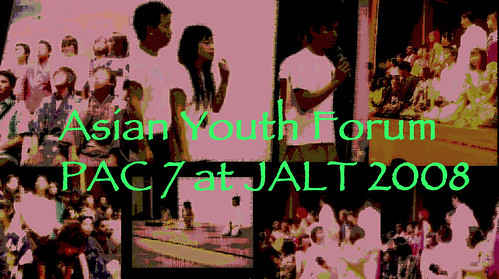







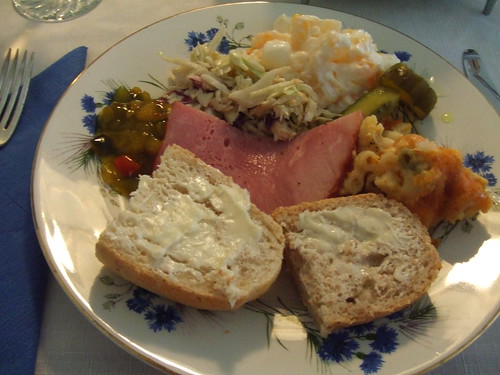
It's going to be great!